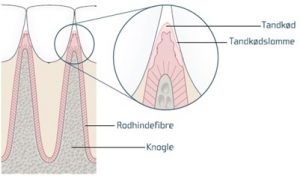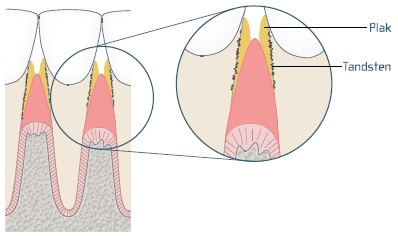Periodontitis, also known as periodontal disease, is gum inflammation that has spread to the surrounding tissues, including the bone and root cementum fibers around the tooth root. This results in permanent loss of the tooth's root cementum fibers with subsequent breakdown of the bone.
If during a routine examination bone loss is detected around 2 or more teeth at 2 mm or above (corresponding to gum pockets of 5 mm or above) and bleeding at the same gum pocket, it indicates periodontitis and treatment should be initiated.
The purpose of treating periodontitis is to stop the disease so that the teeth do not lose more bone support and, in the worst case, are not lost.
During periodontitis treatment, tartar and bacteria in the gum pocket are removed, and the root surfaces are smoothed. Local anesthesia may be necessary if the gums are very tender. Instructions will also be given on how to keep the teeth clean to prevent the disease from progressing further. Studies have shown that home care is extremely important for a successful treatment of periodontitis. Therefore, it is crucial to focus on good oral hygiene. In cases of advanced periodontitis, it may be necessary to supplement root cleanings with gum surgery. This type of treatment is always performed under local anesthesia. It is a relatively minor procedure and there should not be significant discomfort or pain afterwards. As a general rule, it is important to resume tooth brushing and interdental cleaning quickly after standard periodontitis treatment to keep the teeth clean and prevent new plaque and tartar buildup.
Healthy gum fits tightly around the tooth. It is light pink and slightly rough on the surface, and does not bleed after thorough tooth brushing, nor after using dental floss, toothpicks, or interdental brushes.

A tooth is held in the jawbone by small root membrane fibers, and the bone is covered by gums. The part of the tooth that can be seen in the mouth is called the crown, while the tooth's root, under healthy conditions, is covered by gums and therefore cannot be seen.
The small fibers from the tooth that anchor the tooth in the bone run all the way up along the tooth root, so some fibers attach to the bone, while others make the gums fit tightly around the tooth. The fibers normally end just below the tooth's crown. At the tooth crown, the gums bend around and form a natural pocket, which under healthy conditions is at most 2-3 mm deep.
Gum inflammation or gingivitis, as it is called in professional terms, is a chronic inflammation of the gums around the teeth. The condition can occur in patients of all ages and is caused by the accumulation of plaque and tartar on and around the teeth. Inflammation is characterized by swollen and reddish gums that may also be tender. In addition, inflamed gums are more prone to bleeding, for example, during brushing and flossing.
The gum pockets around the teeth become deeper, and the tooth is not as firmly held in the bone. In other words, untreated gum inflammation can develop into periodontitis.
The more severe the periodontitis, the deeper the gum pockets become – and the looser the teeth become.

*Illustrations borrowed from tandlaegeforeningen.dk